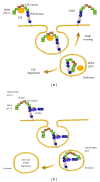Proprotein convertase subtilisin/kexin type 9: from the discovery to the development of new therapies for cardiovascular diseases
- PMID: 24278757
- PMCID: PMC3820617
- DOI: 10.6064/2012/927352
Proprotein convertase subtilisin/kexin type 9: from the discovery to the development of new therapies for cardiovascular diseases
Abstract
The identification of the HMG-CoA reductase inhibitors, statins, has represented a dramatic innovation of the pharmacological modulation of hypercholesterolemia and associated cardiovascular diseases. However, not all patients receiving statins achieve guideline-recommended low density lipoprotein (LDL) cholesterol goals, particularly those at high risk. There remains, therefore, an unmet medical need to develop additional well-tolerated and effective agents to lower LDL cholesterol levels. The discovery of proprotein convertase subtilisin/kexin type 9 (PCSK9), a secretory protein that posttranscriptionally regulates levels of low density lipoprotein receptor (LDLR) by inducing its degradation, has opened a new era of pharmacological modulation of cholesterol homeostasis. This paper summarizes the current knowledge of the basic molecular mechanism underlying the regulatory effect of LDLR expression by PCSK9 obtained from in vitro cell-cultured studies and the analysis of the crystal structure of PCSK9. It also describes the epidemiological and experimental evidences of the regulatory effect of PCSK9 on LDL cholesterol levels and cardiovascular diseases and summarizes the different pharmacological approaches under development for inhibiting PCSK9 expression, processing, and the interaction with LDLR.
Figures

Similar articles
-
Targeting the proprotein convertase subtilisin/kexin type 9 for the treatment of dyslipidemia and atherosclerosis.J Am Coll Cardiol. 2013 Oct 15;62(16):1401-8. doi: 10.1016/j.jacc.2013.07.056. Epub 2013 Aug 21. J Am Coll Cardiol. 2013. PMID: 23973703 Review.
-
Cyclase-associated protein 1 is a binding partner of proprotein convertase subtilisin/kexin type-9 and is required for the degradation of low-density lipoprotein receptors by proprotein convertase subtilisin/kexin type-9.Eur Heart J. 2020 Jan 7;41(2):239-252. doi: 10.1093/eurheartj/ehz566. Eur Heart J. 2020. PMID: 31419281 Free PMC article.
-
Proprotein convertase subtilisin/kexin type 9 (PCSK9) inhibitors: Present perspectives and future horizons.Nutr Metab Cardiovasc Dis. 2016 Oct;26(10):853-62. doi: 10.1016/j.numecd.2016.05.006. Epub 2016 May 30. Nutr Metab Cardiovasc Dis. 2016. PMID: 27352986 Review.
-
Quercetin-3-glucoside increases low-density lipoprotein receptor (LDLR) expression, attenuates proprotein convertase subtilisin/kexin 9 (PCSK9) secretion, and stimulates LDL uptake by Huh7 human hepatocytes in culture.FEBS Open Bio. 2014 Sep 2;4:755-62. doi: 10.1016/j.fob.2014.08.003. eCollection 2014. FEBS Open Bio. 2014. PMID: 25349780 Free PMC article.
-
Proprotein Convertase Subtilisin/Kexin-Type 9 and Lipid Metabolism.Adv Exp Med Biol. 2020;1276:137-156. doi: 10.1007/978-981-15-6082-8_9. Adv Exp Med Biol. 2020. PMID: 32705598 Review.
Cited by
-
PCSK9 Affects Astrocyte Cholesterol Metabolism and Reduces Neuron Cholesterol Supplying In Vitro: Potential Implications in Alzheimer's Disease.Int J Mol Sci. 2022 Oct 13;23(20):12192. doi: 10.3390/ijms232012192. Int J Mol Sci. 2022. PMID: 36293049 Free PMC article.
-
Anti-atherosclerotic therapies: Milestones, challenges, and emerging innovations.Mol Ther. 2022 Oct 5;30(10):3106-3117. doi: 10.1016/j.ymthe.2022.08.024. Epub 2022 Sep 5. Mol Ther. 2022. PMID: 36065464 Free PMC article. Review.
-
Preclinical models of atherosclerosis: An overview.Iran J Basic Med Sci. 2024;27(5):535-542. doi: 10.22038/IJBMS.2024.74352.16148. Iran J Basic Med Sci. 2024. PMID: 38629090 Free PMC article. Review.
-
Pleiotropy of PCSK9: Functions in Extrahepatic Tissues.Curr Cardiol Rep. 2023 Sep;25(9):979-985. doi: 10.1007/s11886-023-01918-2. Epub 2023 Jul 10. Curr Cardiol Rep. 2023. PMID: 37428313 Review.
-
Short- and long-term effects of xuezhikang, an extract of cholestin, on serum proprotein convertase subtilisin/kexin type 9 levels.Chin J Integr Med. 2016 Feb;22(2):96-100. doi: 10.1007/s11655-014-1846-y. Epub 2014 Jul 4. Chin J Integr Med. 2016. PMID: 24993334 Clinical Trial.
References
-
- Puente XS, Sanchez LM, Overall CM, Lopez-Otin C. Human and mouse proteases: a comparative genomic approach. Nature Reviews Genetics. 2003;4(7):544–558. - PubMed
-
- Seidah NG, Prat A. The biology and therapeutic targeting of the proprotein convertases. Nature Reviews Drug Discovery. 2012;11:367–383. - PubMed
-
- Benjannet S, Rhainds D, Essalmani R, et al. NARC-1/PCSK9 and its natural mutants: zymogen cleavage and effects on the low density lipoprotein (LDL) receptor and LDL cholesterol. Journal of Biological Chemistry. 2004;279(47):48865–48875. - PubMed
Publication types
LinkOut - more resources
Full Text Sources
Other Literature Sources
Miscellaneous

